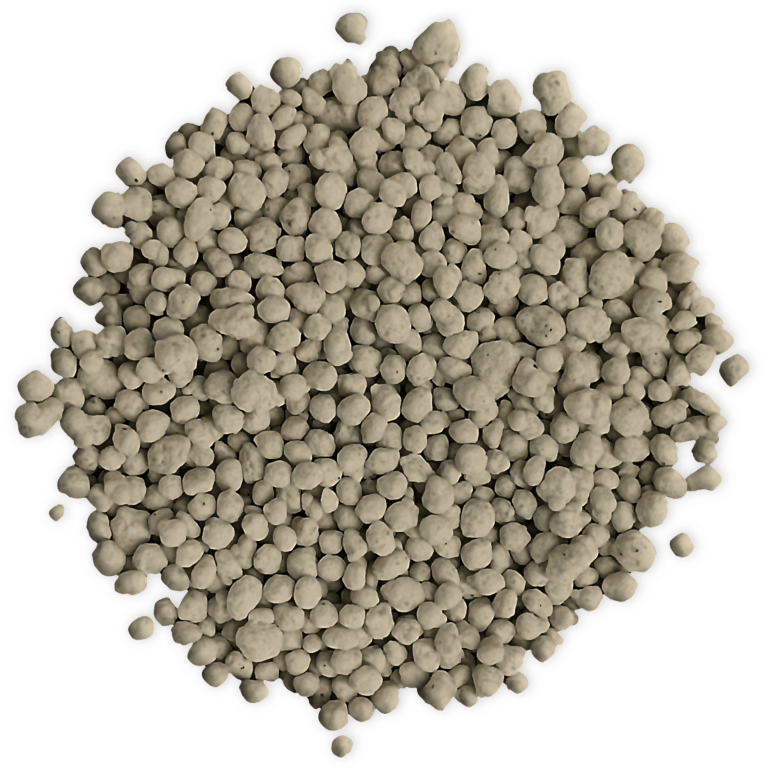
Technical specification
NPК 9:25:25 + 1 S inorganic complex fertilizer is a product obtained chemically by neutralization of extraction phosphoric acid with ammonia, addition of potassium chloride and subsequent granulation of the product.
This granular complex fertilizer contains nitrogen, phosphorus and potassium – the three essential plant nutrients required to maximize crop yield and quality. It is a product that meets the specific crop requirements for nutrient concentration during the different phases of development. It is applied during the pre-sowing or in-sowing period and as a main fertilization for all agricultural crops.
In the initial phase of their development, crops uses а relatively small amount of the absorbed nitrogen. A shortage of readily available nitrogen immediately after crop emergence affects adversely root development and thus limits the uptake of other nutrients. Nitrogen deficiency at the beginning of the growing season and its excess in the second half of the growing season limits crop growth, development and productivity.
Phosphorus in NPК 9:25:25 + 1 S helps to form a tighter structure of the plant organism, which contributes to increasing the resistance of plants to diseases and pests, stimulates the growth of the root system and accelerates crop development. The high chlorophyll content often results from phosphorus deficiency and nitrogen excess that lead to dark green plant color. Another advantage of phosphorus is that it corrects the adverse effects of excessive nitrogen fertilisation by protecting cereals (wheat and barley) from lodging.
The presence of potassium in the product helps plants to overcome periods of drought more easily and to have more active photosynthesis. Potassium enhances leaf growth and slows down leaf senescence, which results in increased yield and quality of crop production. In cereals, the most intensive potassium uptake occurs during tillering and flowering, and in corn – after 7–8 leaf formation and booting.
Sulfur is vital for the formation of the living cell. It is a constituent of all plant proteins and takes an active part in plant nitrogen metabolism. The role of sulfur in the formation of proteins is extremely important as it composes many amino acids (cysteine and cystine).
In the absence of sulfur, the chlorophyll content of leaves is reduced and crop growth is stunted. Sulfur does not undergo reutilization (reuse) in the plant organism. Young leaves turn light green, chlorotic or almost white. In some cases, their form is changed. Older leaves remain green as they do not degrade the sulfur-containing organic compounds. With prolonged starvation, the whole plant turns yellow. An anthocyan color may also appear and the leaves may turn purple or brown. In case of severe sulfur deficiency, the stem of the plant shortens and becomes thinner and later turns woody.
They are transported packed or in bulk. They are offered in packages of polyethylene and polypropylene, in packages of:
— 50 kg
— 500 kg
Advantages
- Source of available nitrogen, phosphorus and potassium for all crops and soils;
- Specially created formulations with added sulfur;
- Easy and even distribution on the field;
- Significant increase of the coefficient of use of nutrients;
- Reduction of the losses from wash-out and lift-off of nutrients.
Technical characteristics
It satisfies the requirements of Regulation 2003/2003 relating to mineral fertilizers with high contents of nitrogen.
| PARAMETER | NORM | HARMONIZED ANALYTICAL STANDARDS |
|---|---|---|
Total Nitrogen (N), % | 9.0 ± 1.9 | BDS EN 15750 |
Ammoniacal Nitrogen, % | 9.0 ± 1.9 | BDS EN 15475 |
Total Phosphorus pentaoxide (P₂O₅), % | 25.0 ± 1.9 | BDS EN 15956; BDS EN 15959 |
Phosphorous pentaoxide (P₂O₅), soluble in neutral ammonium citrate, % | 24.0 ± 1.9 | BDS EN 15957; BDS EN 15959 |
Phosphorous pentaoxide (P₂O₅), soluble in water, % | 23.0 ± 1.9 | BDS EN 15958; BDS EN 15959 |
Potassium (as K₂O), soluble in water, % | 25.0 ± 1.9 | BDS EN 15477 |
Total Sulphur (S), % | 1.0-0.8/+1.6 | BDS EN 15960; BDS EN 15749 |
Content of Water *, % | max 2.0 | BDS EN 13466-1 |
Granulometry: granules 1-5 mm | min 98 | BDS EN 1235 |
Cadmium (Cd)*, mg/kg P₂O₅ | max 60 | BDS EN 16319 + А1 |
Hexavalent Chromium (Cr VI)*, mg/kg dry matter | max 2.0 | BDS EN 16318 + А1 |
Mercury (Hg)*, mg/kg dry matter | max 1 | BDS EN 16320 + А1 |
Nickel (Ni)*, mg/kg dry matter | max 100 | BDS EN 16319 + А1 |
Lead (Pb)*, mg/kg dry matter | max 120 | BDS EN 16319 + А1 |
Arsenic (As)*, mg/kg dry matter | max 40 | BDS EN 16317 + А1 |
Crops

Barley

Rapeseed

Sugar beet

Oats

Wheat

Sunflower

Soybeans

Silage corn

Potatoes

Perennial grasses

Corn

